16.2 Other Aromatic Substitutions
There are many other kinds of electrophilic aromatic substitutions besides bromination, and all occur by the same general mechanism. Let’s look at some of these other reactions briefly.
Aromatic Halogenation
Chlorine and iodine can be introduced into aromatic rings by electrophilic substitution reactions just as bromine can, but fluorine is too reactive and only poor yields of monofluoroaromatic products are obtained by direct fluorination. Instead, other sources of “F+” are used, in which a fluorine atom is bonded to a positively charged nitrogen. One of the most common such reagents goes by the acronym F-TEDA-BF4 in the presence of trifluoromethanesulfonic acid (TfOH). (You don’t need to know the full name of F-TEDA, which is sold under the name Selectfluor.)
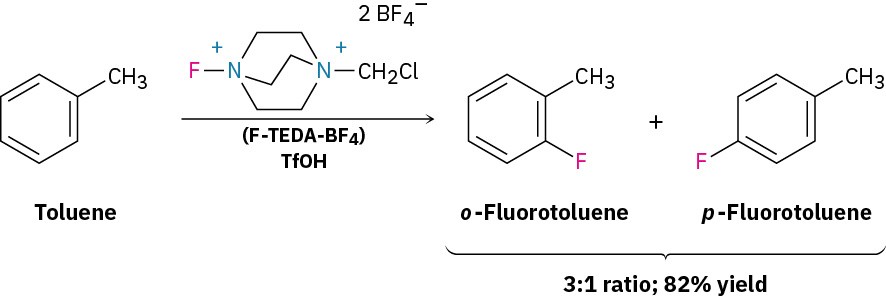
More than 20% of all pharmaceutical agents sold contain fluorine, including 30% of the top 100 drugs sold. Sitagliptin (Januvia), used to treat type 2 diabetes, fluoxetine (Prozac), an antidepressant, and atorvastatin (Lipitor), a statin used to lower cholesterol, are examples.
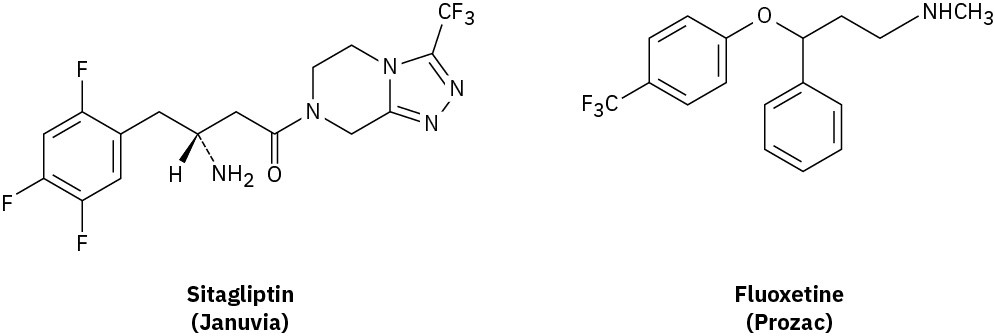
Aromatic rings react with Cl2 in the presence of FeCl3 catalyst to yield chlorobenzenes, just as they react with Br2 and FeBr3. This kind of reaction is used in the synthesis of numerous pharmaceutical agents, including the antiallergy medication loratadine, marketed as Claritin.
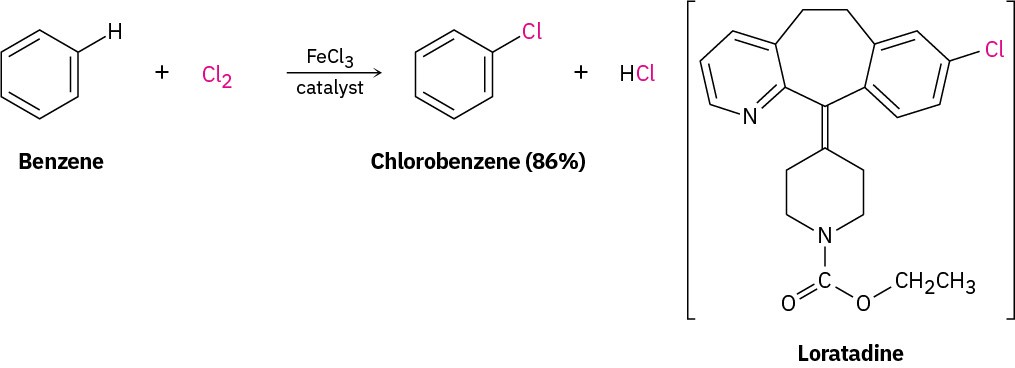
Iodine itself is unreactive toward aromatic rings, so an oxidizing agent such as hydrogen peroxide or a copper salt such as CuCl2 must be added to the reaction. These substances accelerate the iodination reaction by oxidizing I2 to a more powerful electrophilic species that reacts as if it were I+. The aromatic ring then reacts with I+ in the typical way, yielding a substitution product.
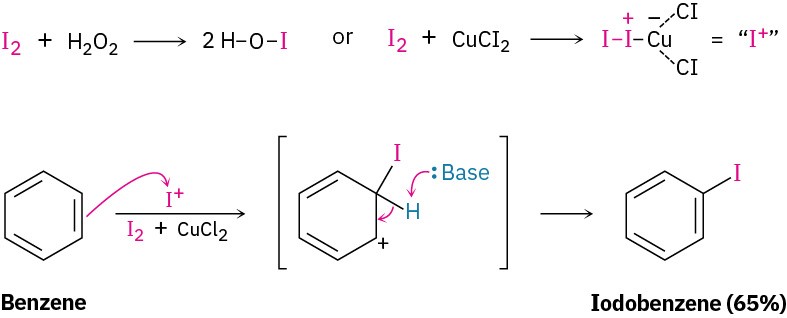
Electrophilic aromatic halogenations also occur in the biosynthesis of many naturally occurring molecules, particularly those produced by marine organisms. In humans, the best-known example occurs in the thyroid gland during the biosynthesis of thyroxine, a hormone involved in regulating growth and metabolism. The amino acid tyrosine is first iodinated by thyroid peroxidase, and two of the iodinated tyrosine molecules then couple. The electrophilic iodinating agent is an I+ species, perhaps hypoiodous acid (HIO), that is formed from iodide ion by oxidation with H2O2.
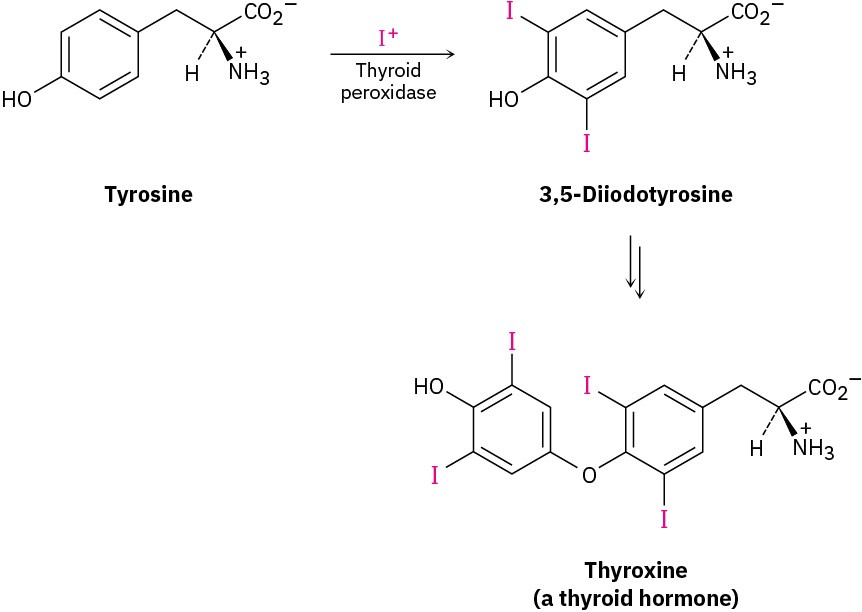
Aromatic Nitration
Aromatic rings are nitrated by reaction with a mixture of concentrated nitric and sulfuric acids. The electrophile is the nitronium ion, NO2+, which is formed from HNO3 by protonation and loss of water. The nitronium ion reacts with benzene to yield a carbocation intermediate, and loss of H+ from this intermediate gives the neutral substitution product, nitrobenzene (Figure 16.5).
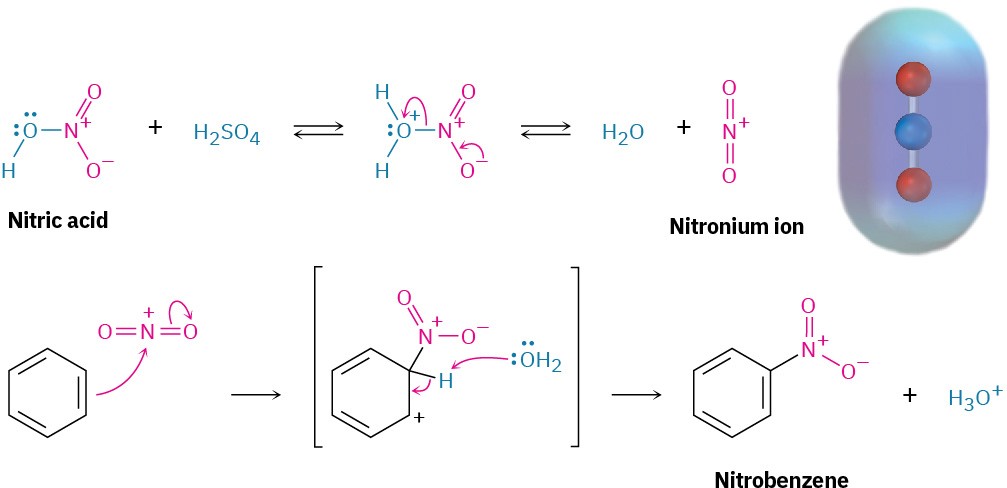
Figure 16.5 The mechanism for electrophilic nitration of an aromatic ring. An electrostatic potential map of the reactive electrophile NO!“ shows that the nitrogen atom is most positive.
Electrophilic nitration of an aromatic ring does not occur in nature but is particularly important in the laboratory because the nitro-substituted product can be reduced by reagents such as iron, tin, or SnCl2 to yield the corresponding arylamine, ArNH2.
Attachment of an amino group (–NH2) to an aromatic ring by the two-step nitration/reduction sequence is a key part of the industrial synthesis of many dyes and pharmaceutical agents. We’ll discuss this reduction and other reactions of aromatic nitrogen compounds in Chapter 24.

Aromatic Sulfonation
Aromatic rings can be sulfonated by reaction with so-called fuming sulfuric acid, a mixture of H2SO4 and SO3. The reactive electrophile is either HSO#“ or neutral SO3, depending on reaction conditions, and substitution occurs by the same two-step mechanism seen previously for bromination and nitration (Figure 16.6). Note, however, that the sulfonation reaction is readily reversible. It can occur either forward or backward, depending on the reaction conditions. Sulfonation is favored in strong acid, but desulfonation is favored in hot, dilute aqueous acid.
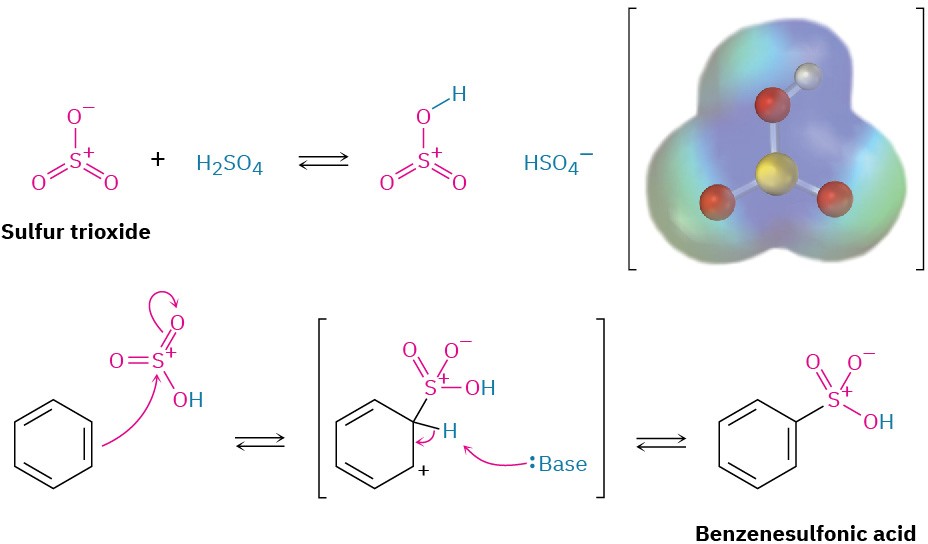
Figure 16.6 The mechanism for electrophilic sulfonation of an aromatic ring. An electrostatic potential map of the reactive electrophile HOSO!“ shows that sulfur and hydrogen are the most positive atoms.
Aromatic sulfonation does not occur naturally but is widely used in the preparation of dyes and pharmaceutical agents. For example, the sulfa drugs, such as sulfanilamide, were among the first clinically useful antibiotics. Although largely replaced today by more effective agents, sulfa drugs are still used in the treatment of meningitis and urinary tract infections. These drugs are prepared commercially by a process that involves aromatic sulfonation as its key step.

Aromatic Hydroxylation
Direct hydroxylation of an aromatic ring to yield a hydroxybenzene (a phenol) is difficult and rarely done in the laboratory but occurs much more frequently in biological pathways. An example is the hydroxylation of p-hydroxyphenylacetate to give 3,4- dihydroxyphenylacetate. The reaction is catalyzed by p-hydroxyphenylacetate-3- hydroxylase and requires molecular oxygen plus the coenzyme reduced flavin adenine dinucleotide, abbreviated FADH2.

By analogy with other electrophilic aromatic substitutions, you might expect that an electrophilic oxygen species acting as an “OH+ equivalent” is needed for the hydroxylation reaction. That is just what happens, with the electrophilic oxygen arising by protonation of FAD hydroperoxide, RO–OH (Figure 16.7); that is, RO–OH + H“ → ROH + OH“. The FAD hydroperoxide itself is formed by reaction of FADH2 with O2.
Figure 16.7 MECHANISM
Mechanism for the electrophilic hydroxylation of p-hydroxyphenylacetate, by reaction with FAD hydroperoxide. The hydroxylating species is an “OH+ equivalent” that arises by protonation of FAD hydroperoxide, RO–OH + H+ → ROH + OH+. The FAD hydroperoxide itself is formed by reaction of FADH2 with O2.
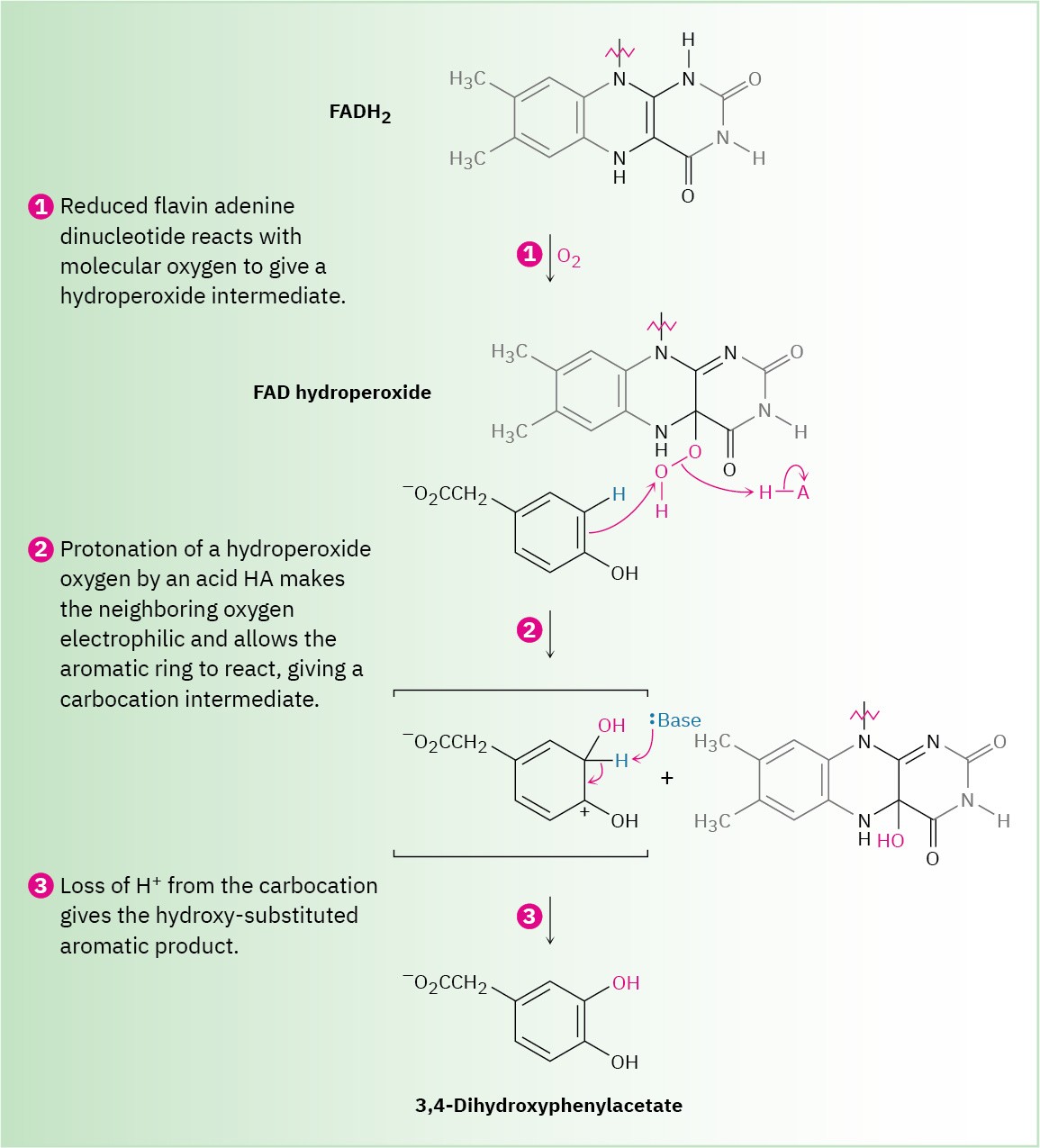
Problem 16-2
Propose a mechanism for the electrophilic fluorination of benzene with SelectFluor. Problem 16-3
How many products might be formed on chlorination of o-xylene (o-dimethylbenzene), m– xylene, and p-xylene?
Problem 16-4
When benzene is treated with D2SO4, deuterium slowly replaces all six hydrogens in the aromatic ring. Explain.

